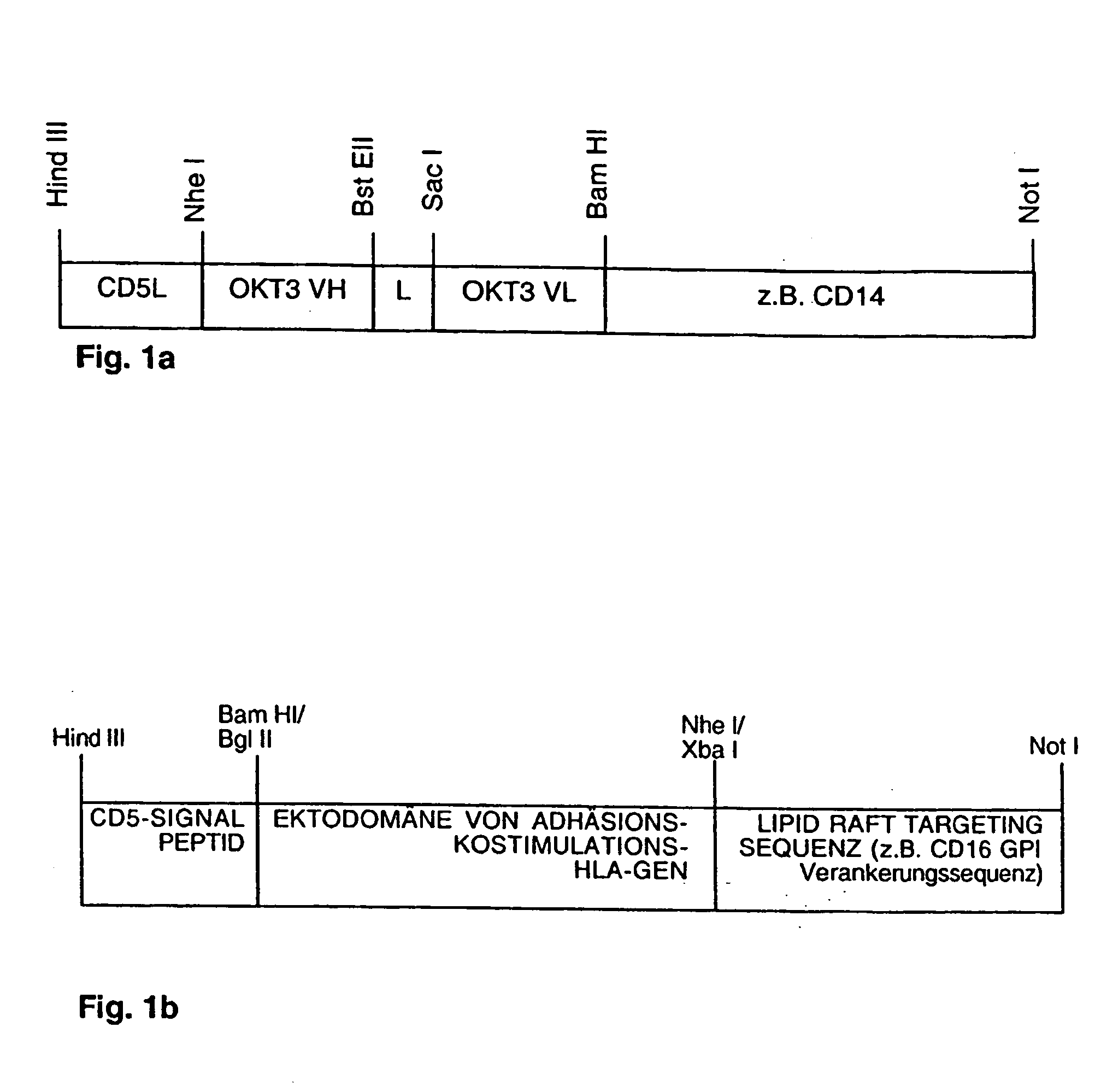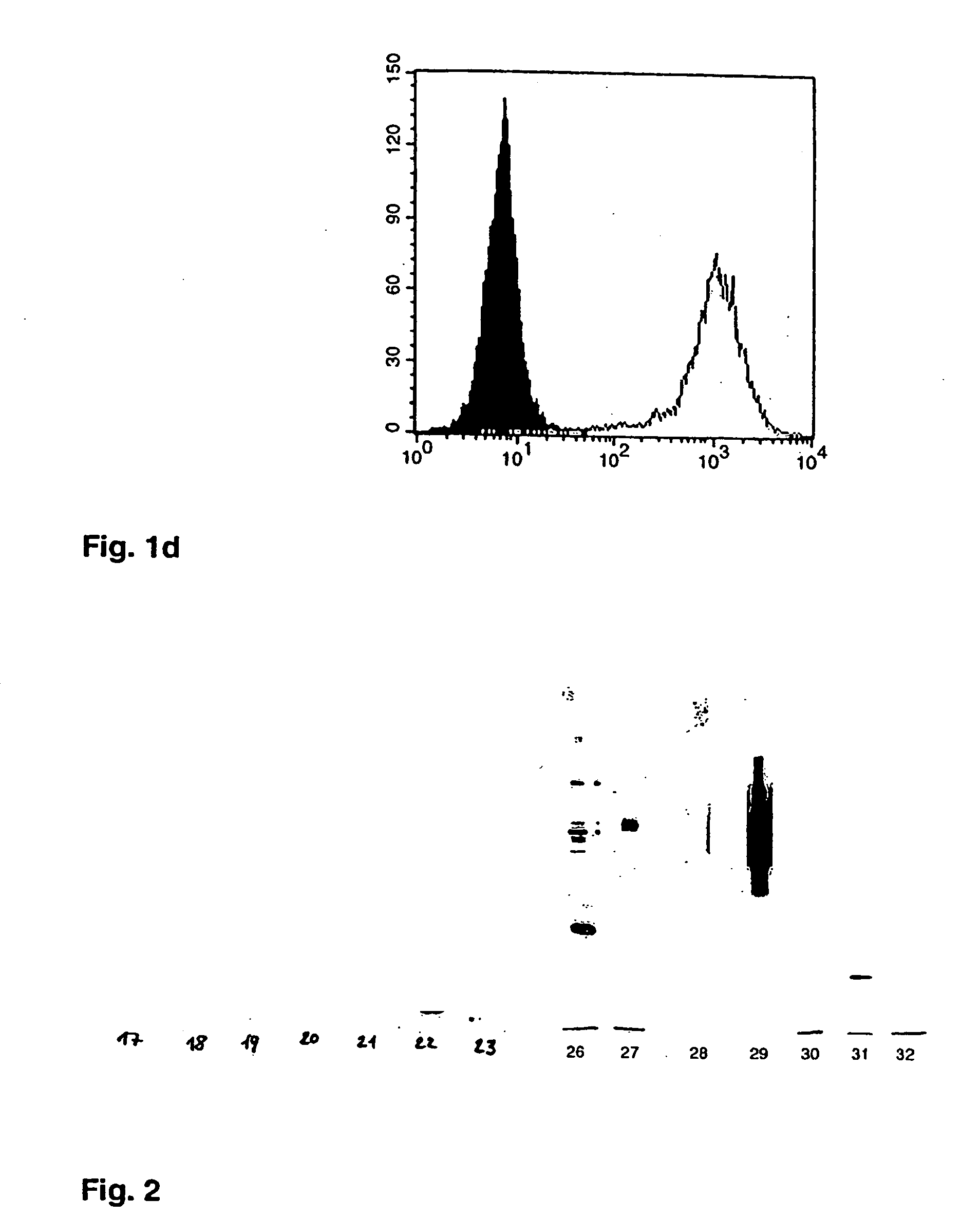Antigen presenting vesicles
- Summary
- Abstract
- Description
- Claims
- Application Information
AI Technical Summary
Benefits of technology
Problems solved by technology
Method used
Image
Examples
example 1
Production of a Subcellular Antigen Presenting Vesicle (SAV)
[0056] A procedure for the generation of said SAV includes the following steps:
[0057] a) Construction of CD5L::CD3-scFv::CD14.
[0058] As a starting material we used a hybridoma cell line, which secreted the anti-human CD3 epsilon mAb OKT3 (American type culture collection). With the help of the salting out procedure we isolated genomic DNA from the hybridoma cell line. The genomic DNA served as a template for the synthetic amplification of DNA fragments encoding the hypervariable regions of the rearranged immunoglobulin VH and VL gene-stretches. For that purpose we amplified the respective DNA regions with the following primers (amplification conditions were chosen as follows: 25 cycles 94° C. 10 sec. 55° C. 10 sec. 72° C. 15 sec):
VH: forGGAATTCGCTAGCCCAGGTCCAGCTGCAG(SEQ ID NO 1)CAGTCT,revGGGGGATCCGGTGACCGTGGTGCCTTGGC(SEQ ID NO 2)CCCAGTA;VL: forGGAATTCGAGCTCCCAAATTGTTCTCACC(SEQ ID NO 3)CAGTCTCCA,revGGGATCCCCACCGCCCCGGTT...
example 2
Morphological Analysis of SAV
[0083] The immunogenic vesicle containing supernatants were ultra centrifuged (100000 g 30 in a Beckman SW-60 rotor, for 1 h, at 4° C.), whereafter the pellet was washed once in PBS followed by an additional centrifugation step as above, after which the pellet was solubilized in SDS-PAGE sample buffer and resolved by SDS-PAGE. The Western blots show that the transfected molecules became highly enriched in the SAV-containing pellet from the supernatants, ditto the constitutively expressed lipid raft resident molecules of the cell line were highly enriched in the SAV (FIG. 2). This confirms that the immunogenic supernatants contain particulate and pelletable material, i.e. subcellular vesicles, and that the SAV contain the molecules that had been targeted intentionally (hypothesis based) to the lipid rafts.
[0084] In addition, ELISA experiments demonstrated that the different transfected molecules are expressed and resident on one and the same particle (S...
example 3
Functional Analysis of SAV
[0087] We tested the potential of said SAV containing vesicles for their effect on peripheral blood mononuclear cells derived from human blood (PBMNC). For that purpose we centrifuged 100.000 cells / well / 100 μl together with (100 μl / well) SAV containing supernatants according to the spinoculation technology, which is broadly used for retroviral transduction of target cells, for 2 hours at 670 g in a SORVALL RTH-250 rotor at 30° C. Subsequently, cells were cultured for three days in a humidified atmosphere in a CO2 incubator. The proliferation of the cells was then monitored for the following 18 hours by determination of the incorporation of 3H-thymidine into the newly synthesized DNA (FIG. 4).
[0088] Experiments performed with highly purified T lymphocytes demonstrated that our SAV stimulate T cells directly without the need for accessory cells (data not shown). In addition, experiments performed with SAV co-expressing PD-L2 along with CD80, CD54 and the su...
PUM
| Property | Measurement | Unit |
|---|---|---|
| adhesion | aaaaa | aaaaa |
| cell surface | aaaaa | aaaaa |
| polymorphic | aaaaa | aaaaa |
Abstract
Description
Claims
Application Information
 Login to View More
Login to View More - R&D
- Intellectual Property
- Life Sciences
- Materials
- Tech Scout
- Unparalleled Data Quality
- Higher Quality Content
- 60% Fewer Hallucinations
Browse by: Latest US Patents, China's latest patents, Technical Efficacy Thesaurus, Application Domain, Technology Topic, Popular Technical Reports.
© 2025 PatSnap. All rights reserved.Legal|Privacy policy|Modern Slavery Act Transparency Statement|Sitemap|About US| Contact US: help@patsnap.com



